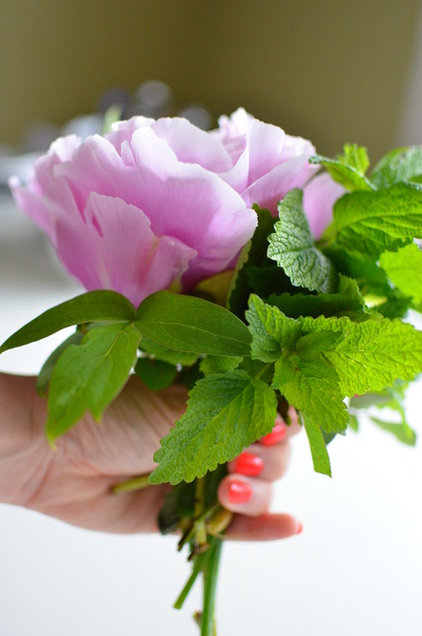 Amy Renea
Cutting Garden
Amy Renea
Cutting GardenA cutting Gainesville Garden has flowers planted specifically to be cut for flower bouquets to enjoy indoors. Your cutting garden does not need to be huge, but it should be big enough to offer a bounty of flowers throughout the season; set aside a corner of the yard and fill it with flowers you love.
 Davis Landscape Design LLC
Choose an out-of-the-way spot that gets full sun for your cutting garden. It will still be enjoyable to look at, but the whole point is to have a place where you can snip blooms freely and not worry about creating blank spots in the garden bed — in other words, don’t put it right in front of the house. If you love cut flowers and have the space, why not replace some of the lawn with a flower meadow?
Davis Landscape Design LLC
Choose an out-of-the-way spot that gets full sun for your cutting garden. It will still be enjoyable to look at, but the whole point is to have a place where you can snip blooms freely and not worry about creating blank spots in the garden bed — in other words, don’t put it right in front of the house. If you love cut flowers and have the space, why not replace some of the lawn with a flower meadow?
 Fifth Season Landscape Design & Construction
What to plant in a cutting garden: Fast-growing flowers like cosmos, black-eyed Susan and snapdragons are satisfying to plant because you will be quickly rewarded for your efforts. But any flower you would love to bring indoors in a bouquet would make a worthy inclusion. Try zinnias, mums, irises, sweet peas, roses and peonies.
Fifth Season Landscape Design & Construction
What to plant in a cutting garden: Fast-growing flowers like cosmos, black-eyed Susan and snapdragons are satisfying to plant because you will be quickly rewarded for your efforts. But any flower you would love to bring indoors in a bouquet would make a worthy inclusion. Try zinnias, mums, irises, sweet peas, roses and peonies.
 Austin Ganim Landscape Design, LLC
Edible Flower Garden
Austin Ganim Landscape Design, LLC
Edible Flower GardenIf you have ever enjoyed a salad or soup with edible flowers sprinkled on top, or admired the sugared flowers adorning a cake, growing an edible flower garden might be of interest to you. Unlike with a cutting Gainesville Garden, you don’t need to plant very much at all to produce enough edible flowers to enjoy in dishes from time to time. A pot or two on the patio, or a few plants edging another bed, will do the trick.
 Jean Marsh Design
What to plant in an edible flower garden: Nasturtium, lavender, violets, pansies and Johnny-jump-ups all have edible blooms. Rose petals are edible as well, though the flavor varies from plant to plant. In the vegetable beds, squash blossoms can be harvested and are delicious when stuffed and fried, or tucked into a quesadilla. Be safe and remember to keep pesticides off edible plants.
Jean Marsh Design
What to plant in an edible flower garden: Nasturtium, lavender, violets, pansies and Johnny-jump-ups all have edible blooms. Rose petals are edible as well, though the flavor varies from plant to plant. In the vegetable beds, squash blossoms can be harvested and are delicious when stuffed and fried, or tucked into a quesadilla. Be safe and remember to keep pesticides off edible plants.
 Monrovia
Dye Garden
Monrovia
Dye GardenDid you know you can create your own natural dyes for fabrics, eggs and other crafty creations, using ingredients harvested from your own backyard? With a dye garden, you can! Berries, flower petals, leaves and roots can be boiled to make homemade dyes in a range of colors.
 Amy Renea
What to plant in a dye garden: Blueberries, blackberries, goldenrod (shown here), marigold, hibiscus, indigo and red cabbage can all be used to make natural dyes. Consult a good how-to book for natural-dye recipes and plan to experiment — natural colors are not as strong or as predictable as commercial dyes.
Amy Renea
What to plant in a dye garden: Blueberries, blackberries, goldenrod (shown here), marigold, hibiscus, indigo and red cabbage can all be used to make natural dyes. Consult a good how-to book for natural-dye recipes and plan to experiment — natural colors are not as strong or as predictable as commercial dyes.
 Amy Renea
Tisane Garden
Amy Renea
Tisane GardenIf you love sipping herb tisanes, why not have a tisane garden? You can choose your favorite herbs, make your own blends and save money in the process. Use herbs fresh from the garden to make tisanes or dry them.
What to plant in a tisane garden: Lemon balm (seen drying here), peppermint, lemon verbena, chamomile, bee balm and yerba buena.
 The New York Botanical Garden
Fragrant Garden
The New York Botanical Garden
Fragrant Garden What could be more delightful than walking through a deliciously scented garden? Plant a fragrant garden in the front of your home, along pathways where you will brush against the fragrant plants, or in a backyard sitting area.
What to plant in a fragrant garden: Fragrant roses (smell before you buy), lavender, lilacs, honeysuckle, jasmine, scented geranium, mint, rosemary, sage and oregano.
 Carolyn Chadwick
Bath Garden
Carolyn Chadwick
Bath Garden Who doesn’t love a relaxing soak in the tub? Always have ingredients for your next soak available when you grow a Gainesville bath garden. Create tub teas, aromatherapy sachets, herbal massage oils or salves for dry skin.
What to plant in a bath garden: Lavender, calendula, chamomile, rosemary and mint.

